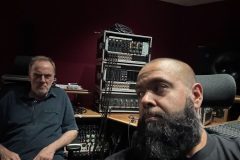One thing I’ve always loved about the DJ-Kicks series is the shroud of mystery because you never know what you’re going to get in return from the artist compiling a group of artists into one release. Yes, it is a compilation that has seen an abundance of releases. Carl Craig, Thievery Corporation, Mr. Scruff, Stereo MCs, and Daddy G (Massive Attack) are but a few names that have contributed to the series, and this time around for its 79th release we have DJ-Kicks: Elkka (!K7 Records). England’s Elkka, known as a DJ/producer and vocalist, has released a few albums and now she takes a hand in compiling some of her own favorites like 70s soulful Shake, Dance/DJs like Omri Smader, Dan Curtin, Jensen Interceptor, and more. Through 24 tracks, there’s a lot to be offered here spanning music from around the globe.
KILL NORMAL – S/T
People just don’t know. This is the little voice inside my head. It often repeats itself, occasionally with venomous bite simply because the general public never wants to latch onto something that’s different, exuberant or downright inviting. But aside from the voice in my head, it boggles my mind that people have become less and less adventurous when it comes to listening to a variety of musical expressions.
The self-titled debut release of Kill Normal is something that’s different. While there’s bombast and noisiness within the group’s music itself, it’s offset with odd vocal melodies at times that are inviting. The group, made up of former Miracle Room vocalist/guitarist Steve Marsh, is joined by his former bandmate, drummer Rock Savage. Rock Savage? Yes, Rock Savage. He’s the former skin beater for NY’s visceral Barkmarket. Rounding out the group is bassist John Nowlin, also of Barkmarket. I make note of this because the group’s rhythm section has worked seamlessly in the past for over a decade. The band is in full swing here with its new release, seven tracks of heavy-hitting dissonance and melody.
With Kill Normal, the songs don’t simply fit the sonic oblivion that many heavy and loud outfits do, there’s structure and thought moving throughout. The opening “Be My Producer,” heavy on the rhythm and filled with Marsh’s exploratory guitar is tongue-in-cheek lyrically. “You’re a television superstar maker / You’re a professional mover & shaker… come on baby and be my producer!” Oh it’s fanciful but these guys, they don’t need a producer, they need a great hype man, which seems they have. The band plays to its strengths and as mentioned previously, it’s full throttle on the rhythm which takes the lead here. It works though. But nothing quite does it more than the song of the same name of the band itself. The group moves in unison and Nowlin’s thick bass wrapped around Savage’s energetic percussion is fantastic. Marsh’s lyrical psychosis delves into schizophrenia as his guitar accentuates the rhythm(s). Yes, this right here is what we need.
There are other moments though where Marsh’s words dramatize the world around us without actually saying it. “Learn To Drive” is direct, or is it? Is he cleverly using metaphors about Christianity, self-righteousness, and other things that infect our minds? Quite possibly. But it’s done over a bed of catchy rhythms and melodies. I’m all in at this point.
Kill Normal has been a long time in the making, which we can be certain was no fault of its own. But there are moments when it takes time to allow certain things to marinate, and right now might be the right moment for Kill Normal.
Facebook | Twitter | Instagram
DRAGG – DARK FIRE HERESY
Shoegaze. Just one word can have a multitude of negative connotations, or it could be the embodiment of lively dramatization if one allows it to. Well, it could also find itself embattled between both, never allowing it to fully thrive or die a quick death. It’s also the one style of music we never imagined would survive decades past the 1900s, but it has and all things considered, it’s flourished at times with the strength of a thousand suns.
Draag is the latest in a long line of artists to make the jump into a pool of swirling elements through cascading walls of melody with the band’s debut full-length, Dark Fire Heresy. The band, Jessica Huang, Ray Montes, Nick Kelley, Shane Graham, and Adrian Acosta, delve in feet first into the genre with an intimate sound that’s alluring with its palatable sweetness. But that shouldn’t deter you or anyone else from discovering the group that takes its lead through 90s-era MBV cooing while still allowing it to have an identity of its own. The attraction here can be heard especially on “Good Era Doom,” where the band doesn’t maneuver itself over the top with its musicality and sultry delivery. The band plays with dynamics ever so slightly while extrapolating a plethora of melodies and harmonies. While on songs like “Animal Specialty” the band may sound like its playing as its forebearers may have in the past, there are fewer questions than answers. The band’s exuberance plays a part in its own identity, which allows Draag to be itself and not a carbon copy of anything or anyone else. You can hear it in “Demonbird” as well which is engulfed in sweetly cooing vocals.
The group does pack a powerful punch of its own accord though and listening to “In the Space Of Time” it becomes even more evident. There’s a punk buoyancy underneath that just can’t be contained. Draag shakes and moves unlike any other, which is quite admirable. “Sin Eating” is different though, lead by a mechanical rhythm as guitars and keys play in the atmosphere around it right before distorted guitars take a more prevalent role. The rhythm and melody are enchanting. But I have to refer back to “Mitsuwa” which sounds oddly familiar. I understand that comparisons are cheap, and while it’s a honeyed and beautiful number, it’s delivery is reminiscent of “Lose My Breath” by MBV. I understand it might be in aesthetic alone but the similarity is clear. With just one hiccup that spans the course of 35 years in between recordings, I’m still willing to look past it.
Dark Fire Heresy, is a really good album and an interesting debut by L.A.’s Draag. The band wears its influences on its sleeve and is completely unapologetic for it. That’s fine considering the songs are strong enough to grasp onto, but also allows Draag to have an identity all its own. I’d love to see where the band goes from here. Expectations are high.
Facebook | Twitter | Instagram
Y LA BAMBA – LUCHA
Have you ever been invested so much into something that you wondered what and where it would lead to? It’s the curiosity that would be the death of you. With Y La Bamba, it seems that’s where all roads lead, directly into the unknown. Of course, you do have a semblance of what may lie ahead but in all honesty, there really is no way of actually knowing. Y La Bamba is the creative output of Luz Elena Mendoza Ramos, vocalist, producer, and visionary who has just released the cross-cultural Lucha (Tender Loving Empire).
While earlier albums like Lupon had moments that were terse and harsh, it has all led up to this, the moment Y La Bamba can be delicate and powerful in both Spanish and English. I keep referring back to “Dibujos De Mi Alma,” a song that sways in the breeze, as Mendoza Ramos sings gently, openly directing a message to someone Mendoza Ramos hasn’t spoken with in some time. The music, and the elegance lie within the percussion as well as the horns and keys that are wrapped around it. The tender bassline, almost lost in the background, is what all the musicians follow as its steady notes are the backbone. The song in of itself is majestic. Ok, we’re done, everyone can go home now. But there’s more here. Lots more.
Following the same gracefulness is “Hues,” a duet with Devendra Banhart. Here amongst the soft din of the musical landscape, Banhart harmonizes with Mendoza Ramos, accentuating the softer voice of the two, as they sing over this old-world track. There’s so much fragility here it could break apart at any moment, but it doesn’t. Instead, it lavishes on the glory of guitars & percussion. It doesn’t end there though as the haunting vocals atop “Nunca” quiver feverishly. The washes of harmonies is easily matched by the song’s instrumentation itself as guitar notes are plucked with sporadic horns blowing in. The magical moments don’t cease to amaze. Now unless someone actually told me, I don’t think I would have realized “I’m So Lonesome I Could Cry,” was a Hank Williams cover song! The song takes its own path, allowing it to become a Y La Bamba song, redundant only to itself. Mendoza Ramos takes a different approach here musically, filled with more harmonies and sparseness. It’s beyond enchanting.
The fight within Lucha isn’t direct in its approach. Instead, it caresses you with its touch, embracing you with warmth and soft emotion, rather than approaching angrily. Lucha is by far, Y La Bamba’s most realized work to date, and that’s not an easy take to accomplish. I’m not sure anyone is actually ready for this.








Social Media